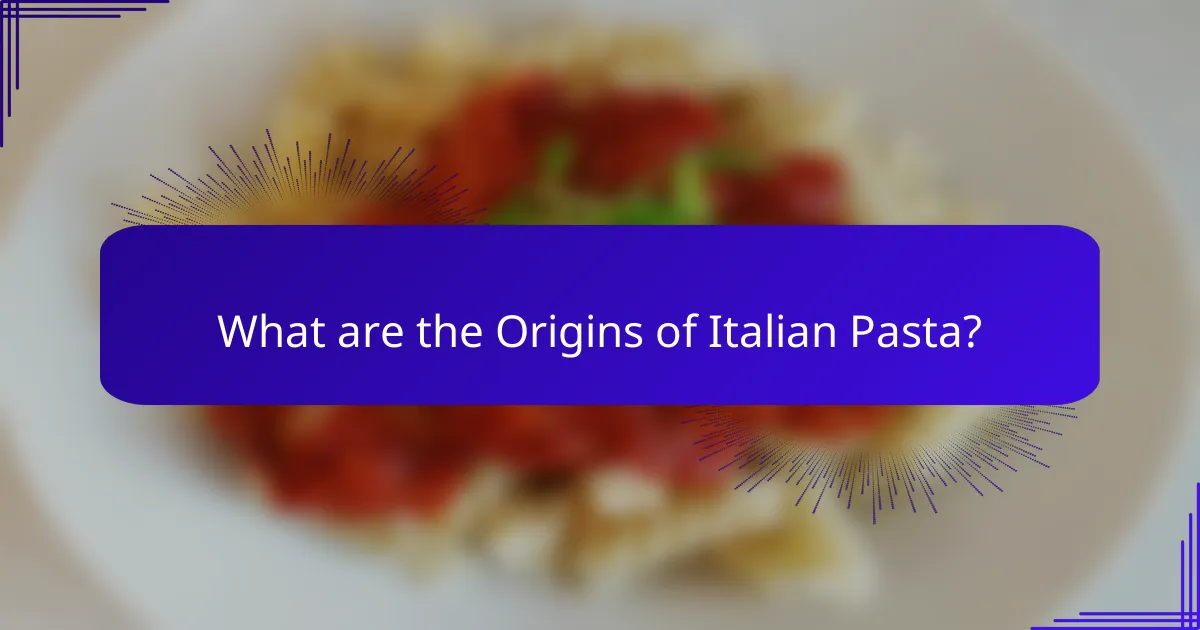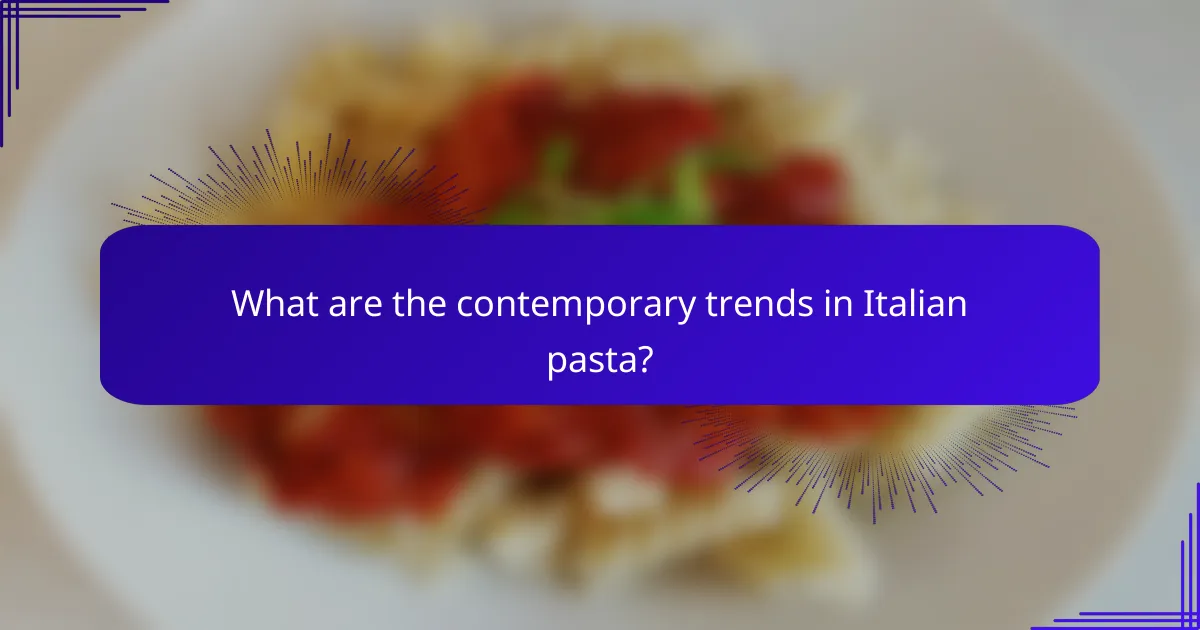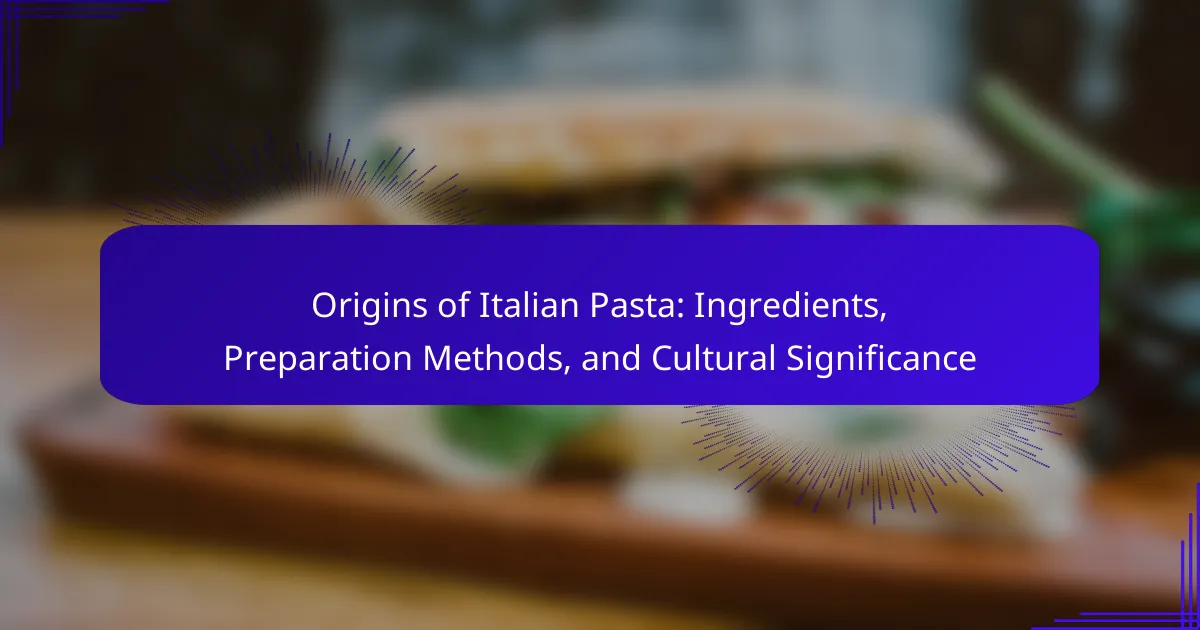
What are the Origins of Italian Pasta?
Italian pasta originated from ancient civilizations, particularly the Etruscans and Romans. Historical records suggest that pasta-like dishes were consumed in Italy as early as 400 B.C. The introduction of durum wheat by the Arabs in the 8th century significantly influenced pasta production. This wheat has a high gluten content, making it ideal for pasta. By the 12th century, pasta became a staple food in Southern Italy. The first documented mention of pasta was in the 13th century, in a Sicilian cookbook. Over time, pasta evolved into various shapes and types, reflecting regional culinary traditions. Today, pasta is a fundamental component of Italian cuisine, celebrated worldwide.
How did pasta evolve in Italy over time?
Pasta evolved in Italy from ancient times to modernity. Its origins trace back to the Etruscans and Romans, who consumed wheat-based dishes. By the Middle Ages, pasta became more popular, particularly in Southern Italy. The introduction of durum wheat led to the development of semolina pasta. In the 16th century, pasta was dried for preservation, enhancing its shelf life. The Industrial Revolution further transformed pasta production with machinery. By the 20th century, pasta became a staple in Italian cuisine, with regional variations emerging. Today, Italy boasts over 600 pasta shapes, each with unique cultural significance.
What historical influences shaped the development of Italian pasta?
Italian pasta developed through various historical influences. The introduction of durum wheat by the Arabs in the 8th century significantly impacted pasta’s texture and quality. The establishment of durum wheat cultivation in Sicily led to the production of high-quality pasta. In the 13th century, pasta became popular in Naples, aided by the city’s trade connections. The influence of the Spanish during their rule in Italy introduced new pasta shapes and recipes. By the 19th century, pasta was widely consumed across Italy, evolving into regional specialties. The industrial revolution further transformed pasta production, making it more accessible to the masses. These historical factors collectively shaped the rich diversity and cultural significance of Italian pasta.
When did pasta become a staple in Italian cuisine?
Pasta became a staple in Italian cuisine by the 14th century. Historical records indicate that pasta was consumed widely in Italy during this period. The first documented mention of pasta in Italy appears in the writings of Francesco di Marco Datini in 1380. By the late Middle Ages, pasta had established itself as a fundamental food item in various regions of Italy. The introduction of durum wheat flour facilitated its production and popularity. Over time, pasta evolved into numerous shapes and forms, becoming integral to Italian culture and dining. Today, pasta is synonymous with Italian cuisine, enjoyed globally in various dishes.
What are the primary ingredients used in Italian pasta?
The primary ingredients used in Italian pasta are flour and water. Flour is typically made from durum wheat, which gives pasta its firm texture. Water is added to the flour to create a dough. Some pasta varieties may also include eggs, which enrich the dough and add flavor. The combination of these ingredients results in the traditional pasta used in Italian cuisine. Historically, the use of durum wheat dates back to ancient Italy, making it a staple in pasta production.
What types of flour are commonly used in pasta making?
Durum wheat flour is the primary type of flour used in pasta making. This flour has a high protein content, which contributes to the pasta’s firm texture. Semolina, a coarser form of durum wheat flour, is also commonly used. It provides a slightly gritty texture and is ideal for shapes like penne and rigatoni. All-purpose flour can be used for fresh pasta, but it results in a softer texture. Whole wheat flour is another option, offering a nuttier flavor and higher fiber content. Each type of flour affects the pasta’s flavor, texture, and cooking properties.
How do eggs and water contribute to pasta’s texture and flavor?
Eggs and water are essential ingredients that significantly influence pasta’s texture and flavor. Eggs provide richness and enhance the pasta’s elasticity. This elasticity helps the pasta hold its shape during cooking. The proteins in eggs also contribute to a firmer texture. Water, on the other hand, hydrates the flour, allowing gluten to develop. This gluten formation is crucial for achieving the desired chewiness in pasta. Additionally, the amount of water affects the dough’s consistency. A well-hydrated dough results in smoother pasta with a better mouthfeel. Together, eggs and water create a balanced dough that is both flavorful and texturally appealing.
What are the traditional preparation methods for Italian pasta?
Traditional preparation methods for Italian pasta include mixing flour and water to create dough. This dough is then kneaded until smooth and elastic. After kneading, it is rolled out into thin sheets or shaped into various forms. Common shapes include tagliatelle, ravioli, and fusilli. The pasta is typically cut by hand or using specialized tools. Once shaped, the pasta is allowed to dry before cooking. Cooking usually involves boiling in salted water until al dente. These methods have been passed down through generations, reflecting regional variations and cultural significance in Italian cuisine.
How is fresh pasta made differently from dried pasta?
Fresh pasta is made using a higher moisture content than dried pasta. Fresh pasta typically consists of flour and eggs, creating a rich, pliable dough. This dough is rolled out and cut into various shapes immediately after preparation. Dried pasta, on the other hand, uses only flour and water. It is extruded into shapes and then dried for several hours to remove moisture. The drying process allows dried pasta to have a longer shelf life. Fresh pasta cooks faster than dried pasta due to its moisture content. Fresh pasta often has a softer texture and is used in dishes where it can be cooked quickly. Dried pasta is firmer and holds up better in longer cooking processes like baking.
What techniques are used to shape different types of pasta?
Pasta shaping techniques include extrusion, rolling, and hand-formed methods. Extrusion involves forcing dough through a die to create shapes like penne or macaroni. Rolling flattens dough into sheets, which can be cut into shapes such as lasagna or tagliatelle. Hand-formed techniques include shaping dough by hand for varieties like orecchiette or gnocchi. These methods have historical significance, with specific techniques often tied to regional traditions in Italy. For example, orecchiette originates from Puglia, where it is traditionally shaped by pressing dough with fingers. Each technique contributes to the texture and cooking properties of the pasta.

What cultural significance does Italian pasta hold?
Italian pasta holds immense cultural significance as a staple of Italian cuisine. It symbolizes regional identity and tradition across Italy. Each region has its own unique pasta shapes and recipes, reflecting local ingredients and customs. For instance, the use of durum wheat in southern Italy contrasts with softer wheat varieties in the north. Pasta is central to Italian family gatherings and celebrations, showcasing its role in social bonding. It is also featured in numerous Italian festivals, emphasizing its importance in cultural heritage. According to the Italian National Institute of Statistics, over 400 types of pasta exist, highlighting its diversity and cultural richness. This culinary tradition has influenced global cuisine, promoting Italian culture worldwide.
How does pasta reflect regional diversity in Italy?
Pasta reflects regional diversity in Italy through its variety of shapes, ingredients, and preparation methods. Each region has unique pasta types that showcase local traditions and resources. For example, northern regions like Lombardy favor stuffed pasta such as ravioli, often filled with cheese or vegetables. In contrast, southern regions like Campania are known for long pasta shapes like spaghetti, often paired with tomato-based sauces.
The ingredients used also vary significantly. In coastal areas, seafood is a common addition, while mountainous regions may incorporate game meats. The preparation methods differ as well; for instance, fresh pasta is often handmade in regions like Emilia-Romagna, while dried pasta is more prevalent in the south.
This regional diversity is further emphasized by local culinary customs and festivals that celebrate specific pasta dishes. For instance, the Sagra degli Gnocchi in Rome highlights potato gnocchi, showcasing the cultural significance of pasta in community gatherings. Thus, pasta serves as a culinary map of Italy, reflecting the rich tapestry of its regional identities.
What are the unique pasta dishes associated with different Italian regions?
Unique pasta dishes vary by Italian region. In Emilia-Romagna, tortellini is a staple, often stuffed with meat. In Naples, spaghetti alle vongole features clams and garlic. Lazio is known for pasta alla carbonara, made with eggs, cheese, and pancetta. In Liguria, trofie al pesto highlights fresh basil pesto. Sicilian pasta alla Norma includes eggplant and ricotta salata. In Puglia, orecchiette con cime di rapa combines pasta with turnip greens. Each dish reflects local ingredients and traditions, showcasing Italy’s diverse culinary landscape.
How do local ingredients influence the preparation of pasta in various regions?
Local ingredients significantly influence the preparation of pasta in various regions. Different regions of Italy utilize locally sourced products to enhance their pasta dishes. For example, in Emilia-Romagna, rich egg pasta is made using local eggs and flour. In contrast, southern regions like Campania often use durum wheat to create firmer pasta types.
Additionally, regions incorporate local vegetables, meats, and cheeses into their pasta recipes. For instance, pesto from Liguria includes fresh basil, pine nuts, and local olive oil. In Sicily, pasta dishes feature ingredients like capers and olives, reflecting the island’s agricultural products.
These regional variations contribute to the distinctive flavors and textures of pasta. Historical practices and local culinary traditions shape these preparations. Therefore, the influence of local ingredients is a key factor in the diversity of pasta across Italy.
Why is pasta considered an integral part of Italian identity?
Pasta is considered an integral part of Italian identity due to its deep historical roots and cultural significance. Originating in Italy as early as the 12th century, pasta has evolved into a symbol of Italian cuisine. It represents regional diversity, with over 300 shapes and forms across Italy. Each region has its unique pasta dishes, reflecting local ingredients and traditions.
The Italian government recognizes pasta as a cultural heritage, promoting its production and consumption. According to the Italian National Institute of Statistics, Italians consume an average of 23.5 kg of pasta per person annually. This highlights its central role in daily life and social gatherings. Pasta is often associated with family, tradition, and community, making it a vital aspect of Italian identity.
What role does pasta play in Italian family traditions and gatherings?
Pasta is central to Italian family traditions and gatherings. It symbolizes unity and togetherness during meals. Families often gather around the table to share pasta dishes. Traditional recipes are passed down through generations. Each region in Italy has its unique pasta types and sauces. Celebrations often feature pasta as a main dish. The preparation of pasta can involve family participation, enhancing bonds. Cultural events frequently highlight pasta in communal feasts, reinforcing its significance.
How is pasta celebrated in Italian festivals and events?
Pasta is celebrated in Italian festivals and events through various culinary traditions and competitions. Festivals often feature pasta as the central dish, showcasing regional specialties. For example, the Sagra della Pasta in Gragnano highlights the local pasta-making heritage. Events frequently include cooking demonstrations and tastings, allowing attendees to experience authentic flavors. Additionally, pasta competitions, such as the Pasta World Championship, emphasize skill and creativity in pasta preparation. These celebrations reflect the cultural significance of pasta in Italian cuisine. They reinforce community bonds and promote local ingredients and traditions.

What are the contemporary trends in Italian pasta?
Contemporary trends in Italian pasta include a focus on health-conscious ingredients and sustainability. Many chefs are incorporating whole grains and alternative flours, such as chickpea or quinoa, into pasta recipes. There is also a growing interest in plant-based pasta options to cater to vegan diets. Additionally, artisanal production methods are gaining popularity, emphasizing traditional techniques and local sourcing of ingredients. The use of innovative shapes and flavors is also trending, with chefs experimenting with infusions like spinach or beetroot. Furthermore, there is an increasing emphasis on pairing pasta with seasonal vegetables and lighter sauces. These trends reflect a shift towards a more health-oriented and environmentally friendly approach to Italian cuisine.
How has globalization influenced Italian pasta recipes?
Globalization has significantly influenced Italian pasta recipes by introducing diverse ingredients and preparation techniques. International trade has made exotic spices and vegetables more accessible in Italy. This has led to the incorporation of flavors from various cuisines into traditional pasta dishes. For instance, Asian ingredients like soy sauce and sesame oil are now used in fusion pasta recipes. Additionally, the rise of global food trends has popularized vegetarian and vegan pasta options. These adaptations reflect changing dietary preferences influenced by global awareness. Studies show that culinary exchanges enhance creativity in traditional recipes. As a result, Italian pasta continues to evolve while maintaining its cultural roots.
What innovative ingredients are being used in modern pasta dishes?
Modern pasta dishes incorporate innovative ingredients such as alternative flours, vegetable purees, and unique proteins. Alternative flours include chickpea, quinoa, and whole grain options. These flours provide different textures and nutritional profiles. Vegetable purees like spinach, beet, and carrot are used to add color and flavor. Unique proteins such as lentils and plant-based sources are gaining popularity in pasta recipes. These ingredients cater to dietary preferences and enhance the overall healthiness of the dish. The use of these innovative ingredients reflects a trend towards healthier and more diverse culinary experiences.
What tips can help enhance the pasta-making experience at home?
To enhance the pasta-making experience at home, focus on using high-quality ingredients. Fresh, organic flour and eggs significantly improve flavor and texture. Invest in a good pasta machine for consistent thickness. Allow the dough to rest for at least 30 minutes; this relaxes gluten and makes rolling easier. Use a generous amount of flour to prevent sticking during shaping. Experiment with different shapes and sizes to explore various pasta types. Cook pasta in a large pot of salted water for optimal flavor. Finally, pair homemade pasta with fresh, complementary sauces for the best taste experience.
How can one achieve the perfect pasta dough consistency?
To achieve the perfect pasta dough consistency, one must balance flour and water. Use a ratio of 100 grams of flour to 1 large egg for a basic dough. Knead the mixture until smooth and elastic, which typically takes about 10 minutes. The dough should be slightly tacky but not sticky. If it’s too dry, add a small amount of water. If too wet, incorporate more flour. Allow the dough to rest for at least 30 minutes before rolling it out. This resting period helps the gluten relax, resulting in a better texture. Properly made pasta dough should hold its shape when formed and have a smooth surface.
What common mistakes should be avoided when cooking pasta?
Common mistakes to avoid when cooking pasta include not using enough water, which can lead to sticky pasta. Cooking pasta in water that isn’t boiling can result in uneven cooking. Adding oil to the cooking water is unnecessary and can prevent sauce adherence. Not salting the water adequately can lead to bland flavor. Overcooking pasta makes it mushy, while undercooking results in a hard texture. Rinsing pasta after cooking washes away flavor and starch. Lastly, not reserving pasta water can hinder sauce consistency. These mistakes can significantly affect the final dish’s quality.
The main entity of the article is Italian pasta, which encompasses its origins, ingredients, preparation methods, and cultural significance. The article traces the historical development of pasta from ancient civilizations to its establishment as a staple in Italian cuisine, highlighting the influence of durum wheat and regional variations. It details the primary ingredients used in pasta making, including flour and water, and explores traditional preparation methods and shaping techniques. Additionally, the article examines the cultural importance of pasta in Italian identity, family traditions, and contemporary trends, as well as the impact of globalization on pasta recipes.
